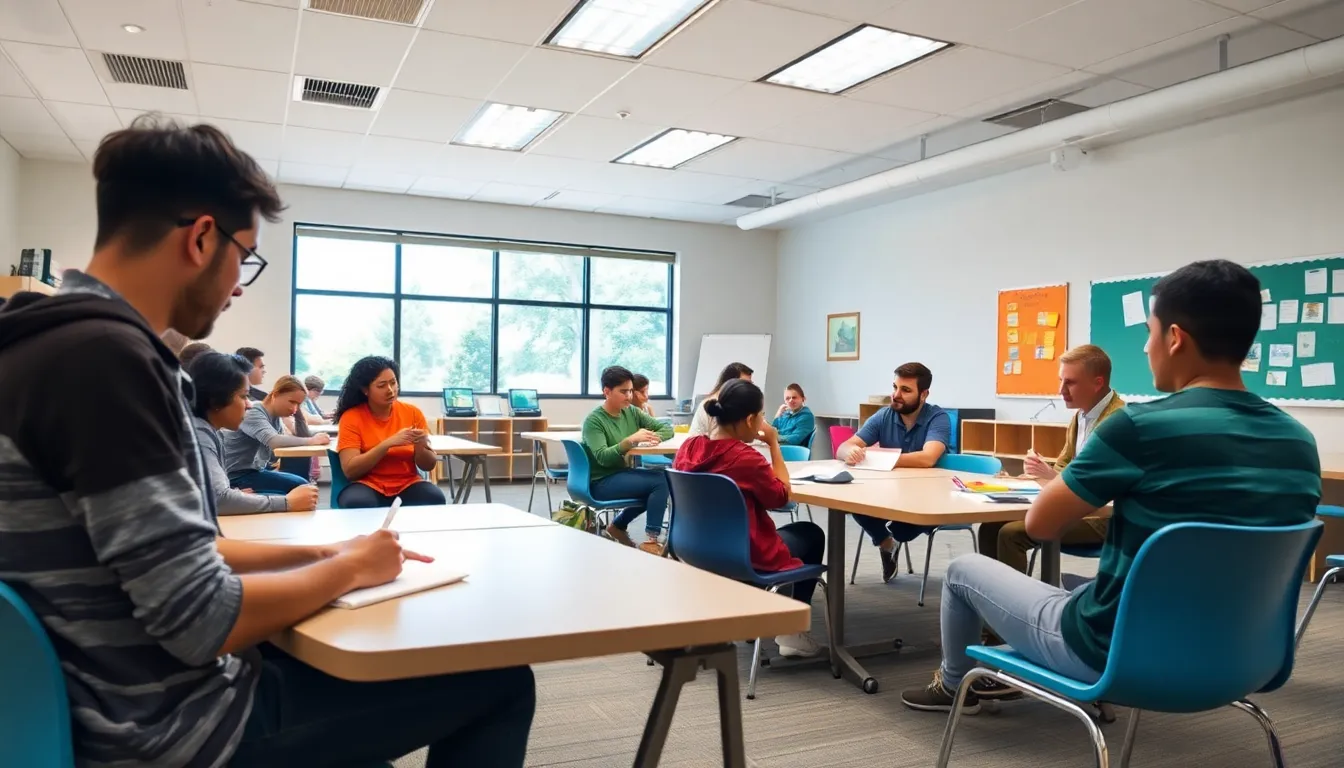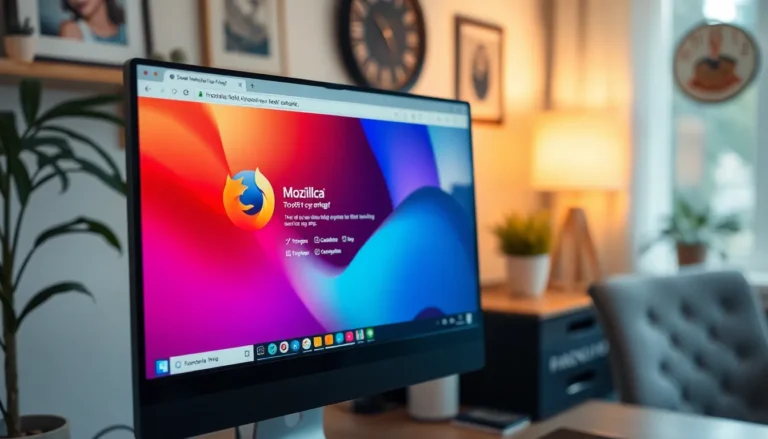Table of Contents
ToggleImagine a classroom where walls are just a suggestion and learning happens in vibrant, open spaces. Welcome to the world of open classrooms, where students trade in traditional desks for collaborative zones that spark creativity and connection. It’s not just about removing walls; it’s about breaking down barriers to education.
What Is an Open Classroom?
An open classroom promotes a flexible learning environment, allowing for collaboration and creativity. This model transforms traditional classrooms into dynamic spaces where students engage with diverse resources and each other.
Definition and Characteristics
An open classroom features a layout that encourages interaction among students and teachers. Its design often includes movable furniture, shared resources, and areas for group activities. Key characteristics include a focus on collaboration, student-led initiatives, and adaptability. In open classrooms, educators design activities that support various learning styles, fostering a sense of community and engagement. This model prioritizes social skills alongside academic achievement, creating a holistic learning experience.
Historical Background
Open classrooms emerged in the 1960s as a response to rigid educational practices. The movement aimed to address the need for more engaging learning environments. Pioneer educators recognized that traditional methods limited students’ potential. Consequently, they advocated for unorthodox approaches, promoting interaction and creativity. Over the years, numerous studies highlighted the benefits of this approach, influencing educational policies across many regions. Schools began to adapt their infrastructure, embracing the principles of the open classroom to enhance overall student outcomes.
Benefits of Open Classrooms

Open classrooms offer significant advantages for both students and educators. This approach transforms learning environments into spaces that promote cooperation and adaptability.
Enhanced Collaboration
Collaboration becomes a central aspect of open classrooms. Students often work together on projects, sharing ideas and resources. This setting encourages communication and teamwork, skills essential for future success. Teachers facilitate discussions, guiding students in group work. Through peer interaction, learners develop social skills and a sense of community. Research shows that collaborative learning improves engagement and retention. Open classrooms create opportunities for diverse perspectives, enriching the educational experience.
Flexibility in Learning Styles
Flexibility addresses the varying learning preferences among students. In open classrooms, educators use different teaching methods to accommodate unique styles. This variety includes visual aids, hands-on activities, and technology integration. Students choose how they engage with materials, allowing personalized learning experiences. Adaptable seating arrangements support movement and interaction, further enhancing engagement. Evidence from educational studies indicates that accommodating multiple learning styles leads to better outcomes. Open classrooms foster an environment where all students can thrive, meeting their individual educational needs.
Challenges of Open Classrooms
Despite the benefits, open classrooms face challenges that can impact the learning experience.
Noise and Distractions
Noise often becomes a problem in open classroom settings. Students may struggle to concentrate due to background chatter. Frequent interruptions can hinder focus, making it difficult to complete tasks. Some students thrive in collaborative environments, while others may feel overwhelmed by constant distractions. Implementing structures like designated quiet areas can help mitigate noise issues. Additionally, teachers may find it challenging to manage classroom dynamics effectively amid the hustle and bustle.
Teacher Adaptation
Adapting to an open classroom model poses significant challenges for educators. Traditional teaching methods often don’t translate well to these flexible spaces. Teachers may need to rethink their approaches to instruction and classroom management. Training programs focused on collaborative techniques and classroom engagement could aid in this transition. Moreover, some teachers might require support while adjusting to student-led initiatives and group-oriented activities. Consequently, developing proficiency in new strategies becomes essential for maintaining effective learning environments.
Case Studies of Open Classroom Implementation
Open classrooms have generated significant interest, resulting in various case studies that showcase their effectiveness. Examples from different schools illustrate both success stories and lessons learned through implementation.
Success Stories
One school in Arizona transformed its traditional classrooms into open spaces that encourage collaboration. Teachers reported increased student engagement and improved teamwork skills. For instance, students frequently collaborated on projects, leading to a 20% rise in academic performance over one year. Another school in California saw a marked change in its community environment, fostering connections among students and teachers. Positive feedback came from parents who appreciated the enhanced learning atmosphere. These success stories highlight the tangible benefits of adopting open classroom designs.
Lessons Learned
Implementing open classrooms also revealed important lessons regarding space management. Schools learned that not all students thrive in open environments. Some individuals preferred quieter settings to focus effectively. Consequently, designated quiet zones emerged as a strategy to help students concentrate. Teacher training played a crucial role in ensuring that educators adapted to new pedagogical approaches. Encouraging collaboration required ongoing professional development. Lastly, schools recognized the need for flexible furniture arrangements to accommodate varying group sizes and activities. These insights can guide future implementations of open classrooms.
Future of Open Classrooms
Open classrooms are evolving to address modern educational needs. Innovations are emerging that emphasize collaboration and creativity, ensuring this model remains relevant.
Trends in Education
Current education trends emphasize personalized learning experiences. Schools increasingly recognize the importance of fostering creativity and critical thinking in students. Blended learning approaches combine traditional instruction with open classroom principles. Collaborative spaces gain popularity, allowing for diverse group activities where students can engage with each other. More educators focus on developing social-emotional skills, preparing students for future challenges. Flexibility in classroom design supports various teaching methods, enhancing student engagement and performance. These trends reflect a commitment to adapting educational practices to benefit all learners.
Technology Integration
Technology plays a vital role in the future of open classrooms. Digital tools facilitate collaboration and enhance learning experiences. Students use devices for research, allowing access to a wealth of information. Applications and platforms that support interactive learning foster engagement and creativity. Teachers leverage technology to track student progress, tailoring instruction to meet individual needs. Virtual reality and augmented reality provide immersive learning opportunities, further enriching the educational environment. This integration promotes a modern approach to education, preparing students for a technology-driven world.
Open classrooms represent a transformative shift in education that prioritizes collaboration and creativity. By breaking down traditional barriers and fostering dynamic learning environments, they enable students to engage more deeply with their peers and resources. The adaptability of these spaces supports diverse learning styles while promoting essential skills like teamwork and communication.
Despite the challenges that may arise, such as noise and the need for effective classroom management, the benefits of open classrooms are evident. As education continues to evolve, embracing technology and innovative teaching methods will ensure these environments remain effective. The future of open classrooms looks promising, paving the way for enriched educational experiences that prepare students for success in a rapidly changing world.





